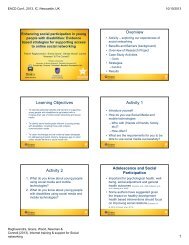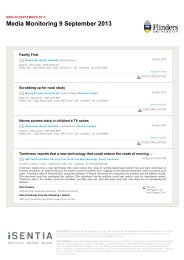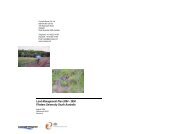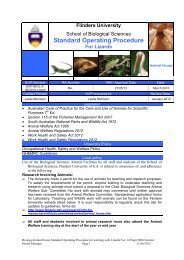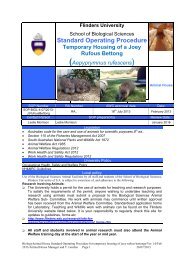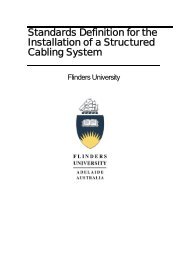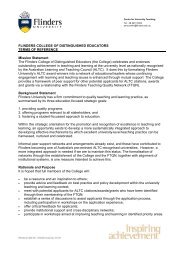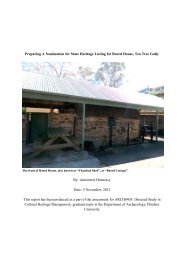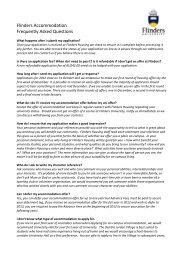Measuring hospital efficiency consistent with maximising net benefit
Measuring hospital efficiency consistent with maximising net benefit
Measuring hospital efficiency consistent with maximising net benefit
You also want an ePaper? Increase the reach of your titles
YUMPU automatically turns print PDFs into web optimized ePapers that Google loves.
Working Paper<br />
No. 2007/01<br />
<strong>Measuring</strong> <strong>hospital</strong> <strong>efficiency</strong> <strong>consistent</strong> <strong>with</strong><br />
<strong>maximising</strong> <strong>net</strong> <strong>benefit</strong><br />
By Simon Eckermann<br />
ISBN-13<br />
978-1-921402-00-5
<strong>Measuring</strong> <strong>hospital</strong> <strong>efficiency</strong> <strong>consistent</strong> <strong>with</strong><br />
<strong>maximising</strong> <strong>net</strong> <strong>benefit</strong><br />
Simon Eckermann*, Flinders University<br />
Abstract<br />
Health effects of care are increasingly being reported in comparing <strong>hospital</strong><br />
performance. However, conventional methods of specifying health effects in<br />
economic <strong>efficiency</strong> measures reflect underlying objectives such as average cost<br />
effectiveness rather than the maximisation of <strong>net</strong> <strong>benefit</strong> established in health<br />
technology assessment. In this paper a correspondence method is identified<br />
which allows the incorporation of health effects in ratio measures of <strong>efficiency</strong><br />
<strong>consistent</strong> <strong>with</strong> the maximisation of <strong>net</strong> <strong>benefit</strong>. The satisfaction of<br />
correspondence conditions of coverage and comparability are also shown to<br />
provide a robust theoretical framework to avoid cost-shifting and cream-<br />
skimming incentives.<br />
Keywords: <strong>hospital</strong> performance; quality of care; maximizing <strong>net</strong> <strong>benefit</strong>;<br />
* Correspondence to:<br />
Simon Eckermann<br />
cost-shifting; cream-skimming.<br />
Associate Professor in Health Economics<br />
Flinders Centre for Clinical Change and Health Care Research,<br />
Flinders University, GPO Box 2100, Adelaide SA 5001 Australia<br />
e-mail: simon.eckermann@flinders.edu.au
1. Introduction<br />
Costs are increasingly compared across <strong>hospital</strong>s in countries such as Australia,<br />
Canada and the United Kingdom. Parallel to this, health and other effects of care<br />
such as mortality, morbidity and readmission are also increasingly being<br />
collected and used to assess aspects of clinical performance across <strong>hospital</strong>s<br />
(e.g. clinical audit, outlier identification) in countries including Australia,<br />
Canada and the UK (Australian Council on Healthcare Standards 2001, National<br />
Health Performance Committee 2000, Wolfson et al. 2002, National Health<br />
Service 2002).<br />
When these same countries compare alternative treatment strategies in processes<br />
of health technology assessment (National Institute for Clinical Excellence<br />
2001, Australian Government Department of Health and Ageing 2002, Ministry<br />
of Health of Ontario 1994), health effects are integrated <strong>with</strong> costs <strong>consistent</strong><br />
<strong>with</strong> an objective of <strong>maximising</strong> <strong>net</strong> <strong>benefit</strong> (Claxton et al. 1996, Stin<strong>net</strong>t et al.<br />
1998). However, a method for integrating the value of health effects in ratio<br />
measures of economic <strong>efficiency</strong> <strong>consistent</strong> <strong>with</strong> the <strong>maximising</strong> of <strong>net</strong> <strong>benefit</strong><br />
has not been identified. Rather, economic <strong>efficiency</strong> measures across such<br />
providers have either:<br />
(i) ignored health effects of care <strong>with</strong> measures such as cost per case-mix<br />
adjusted separation;<br />
(ii) modelled health effects as exogenous parameters in <strong>efficiency</strong><br />
measurement (e.g. (Zuckerman et al. 1994), and hence been unable to<br />
include the value of such effects in estimating economic or allocative<br />
<strong>efficiency</strong>; or<br />
Eckermann S., <strong>Measuring</strong> <strong>hospital</strong> <strong>efficiency</strong> <strong>consistent</strong> <strong>with</strong> <strong>maximising</strong> <strong>net</strong> <strong>benefit</strong><br />
1
(iii) specified health effects as utility bearing outputs in <strong>efficiency</strong><br />
measurement (Gregan et al. 1997, Puig-Junoy 1998, Dawson et al. 2005),<br />
representing, where identifiable, objectives such as average cost per unit<br />
effect (average cost effectiveness).<br />
The objective of this paper is to identify a systematic method for including<br />
health effects of care in ratio measures of economic <strong>efficiency</strong> <strong>consistent</strong> <strong>with</strong><br />
<strong>maximising</strong> <strong>net</strong> <strong>benefit</strong>. The paper is structured as follows. A correspondence is<br />
identified between<br />
(1) <strong>maximising</strong> <strong>net</strong> <strong>benefit</strong>, and<br />
(2) minimising the sum of costs and effects framed from a disutility<br />
perspective valued at the same mo<strong>net</strong>ary amount per unit of effect as <strong>net</strong><br />
<strong>benefit</strong>.<br />
This correspondence is shown to allow a method of economic <strong>efficiency</strong><br />
measurement in the cost-disutility plane <strong>consistent</strong> <strong>with</strong> <strong>maximising</strong> <strong>net</strong> <strong>benefit</strong>.<br />
This method is then applied to compare relative <strong>efficiency</strong> of <strong>hospital</strong> activities.<br />
Finally the differences between methods to allow for quality of care in<br />
<strong>efficiency</strong> measurement proposed previously and that proposed in this paper are<br />
clarified and their relative merits discussed in conclusion.<br />
2. <strong>Measuring</strong> economic <strong>efficiency</strong> of <strong>hospital</strong>s <strong>consistent</strong> <strong>with</strong> an<br />
appropriate objective<br />
Economic performance measures across <strong>hospital</strong>s have historically ignored<br />
health effects and other quality of care indicators and concentrated on<br />
‘homogenous’ intermediate measures of <strong>hospital</strong> output such as case-mix<br />
Eckermann S., <strong>Measuring</strong> <strong>hospital</strong> <strong>efficiency</strong> <strong>consistent</strong> <strong>with</strong> <strong>maximising</strong> <strong>net</strong> <strong>benefit</strong><br />
2
adjusted admissions. This concentration on intermediate outputs has been:<br />
“largely because measurement problems are less constraining.” (McGuire et al.<br />
1988 p.218).<br />
However, economic performance measures such as cost per case-mix adjusted<br />
admission which include costs of (implicitly), but ignore health effects of,<br />
quality of care, do not create appropriate incentives for quality of care. Health<br />
effects and costs of care are jointly influenced by quality of care and hence<br />
including the cost but not the value of quality in <strong>efficiency</strong> measurement creates<br />
incentives for cost minimising, rather than a clinically neutral quality of care.<br />
The importance of considering the joint relationship between value and cost of<br />
quality was suggested by Harris (1977) in his paper on the internal organisation<br />
of the <strong>hospital</strong>, split between clinicians <strong>with</strong> an objective of health<br />
maximisation, and administrators <strong>with</strong> an objective of cost minimisation:<br />
“The failure to recognize that doctors and <strong>hospital</strong>s are linked by a strong<br />
bond of joint production is the basis of many of the <strong>hospital</strong>s inefficiencies.”<br />
(Harris 1977 p.475).<br />
The desirability of taking into account value (of effects) as well as costs of<br />
quality of care is further reinforced when considering the impact of quality of<br />
<strong>hospital</strong> services on costs and health effects of patients post <strong>hospital</strong> separation.<br />
Health systems are often characterised by incomplete vertical integration across<br />
health services (Evans 1981). Consequently, quality of <strong>hospital</strong> care <strong>with</strong>in an<br />
admission can have significant impact beyond post separation on the wider<br />
health system. Where <strong>hospital</strong>s are not held accountable for the expected effects<br />
Eckermann S., <strong>Measuring</strong> <strong>hospital</strong> <strong>efficiency</strong> <strong>consistent</strong> <strong>with</strong> <strong>maximising</strong> <strong>net</strong> <strong>benefit</strong><br />
3
of their care beyond separation, perverse economic incentives are created for<br />
practices such as quicker-sicker care, cost-shifting and quality-skimping (Smith<br />
2002). For example, <strong>with</strong> performance measured by cost per case-mix adjusted<br />
separation, performance improves when <strong>with</strong>in admission costs per patient fall<br />
and hence providers can improve performance by earlier release of sick patients<br />
(quicker-sicker care). However, while such practices can reduce cost per<br />
admission, they have expected negative effects on health effects beyond <strong>hospital</strong><br />
separation (effect or outcome shifting) and consequently increase expected<br />
demands for and use of care post-discharge (cost-shifting). Such cost-shifting<br />
may manifest in increasing rates of readmission to <strong>hospital</strong>s, treatment in other<br />
institutional settings (general practice, specialist and aged care services), or<br />
informal care in non-institutional settings. Accounting for the health effects of<br />
patients over time in <strong>efficiency</strong> measurement would therefore appear to be<br />
necessary to avoid perverse incentives and create incentives for appropriate<br />
quality of care. However, while accounting for health effects is suggested to be<br />
desirable in creating appropriate incentives for quality of care and such health<br />
effects of care over time are increasingly being measured, the question remains<br />
as to how they should be included in <strong>efficiency</strong> measurement.<br />
Health economists have stressed the importance of evaluating strategies relative<br />
to a comparator and informing decision makers of incremental rather than<br />
average cost–effectiveness ratios (Drummond et al. 1997, Drummond et al.<br />
1987, Drummond et al. 2005). This rejection of average cost effectiveness ratios<br />
in favour of incremental cost effectiveness ratios reflects the incremental and<br />
non-tradable nature of health effects of care in treated populations (McGuire et<br />
Eckermann S., <strong>Measuring</strong> <strong>hospital</strong> <strong>efficiency</strong> <strong>consistent</strong> <strong>with</strong> <strong>maximising</strong> <strong>net</strong> <strong>benefit</strong><br />
4
al. 1988 p.32, Eckermann 2004 p. 134-135). The impact on patients of a process<br />
of care or intervention require consideration relative to alternatives (even if<br />
doing nothing) and generally will be specific to, and not repeatable in, the<br />
patient population receiving them.<br />
Decision making based on considering incremental health effects relative to the<br />
incremental cost of alternative strategies was suggested by Claxton and Pos<strong>net</strong>t<br />
(1996) as equivalent to maximizing the <strong>net</strong> value of incremental effects of a<br />
technology at a threshold value for effects minus incremental costs. Stin<strong>net</strong>t and<br />
Mullahy (1998) described this <strong>net</strong> value of incremental effects less incremental<br />
costs for a strategy relative to a comparator as <strong>net</strong> <strong>benefit</strong>. Net <strong>benefit</strong> under<br />
these definitions can either be represented as incremental <strong>net</strong> mo<strong>net</strong>ary <strong>benefit</strong><br />
where incremental effects are measured in mo<strong>net</strong>ary terms or equivalently as<br />
incremental <strong>net</strong> effect <strong>benefit</strong> where incremental costs are measured in terms of<br />
equivalent units of effect. Formally, incremental <strong>net</strong> mo<strong>net</strong>ary <strong>benefit</strong> (INMB)<br />
per patient and incremental <strong>net</strong> effect <strong>benefit</strong> (INEB) per patient can be<br />
represented for a given strategy (i), relative to a comparator (c), as:<br />
INMB = k( E −E) −( C − C )<br />
(1)<br />
i i c i c<br />
1<br />
INEBi = ( Ei −Ec) − ( Ci − Cc)<br />
(2)<br />
k<br />
where k represents the decision makers’ willingness to pay per unit of effect, E<br />
is effect per patient, and C is cost per patient.<br />
Historically, methods proposed to include effects of care such as mortality,<br />
morbidity and readmission in <strong>efficiency</strong> measurement have attempted to specify<br />
them under the ‘quality-quantity trade-off’ suggested by Newhouse (Newhouse<br />
Eckermann S., <strong>Measuring</strong> <strong>hospital</strong> <strong>efficiency</strong> <strong>consistent</strong> <strong>with</strong> <strong>maximising</strong> <strong>net</strong> <strong>benefit</strong><br />
5
1970). Methods previously suggested for specifying health effects in<br />
performance measurement under this trade-off can be broadly characterised as:<br />
(i) Exogenous methods: Conditioning of activity-based measures of<br />
performance on rates of health effects, for example in the study of<br />
Zuckermann et al.(1994) adjusting comparison of cost per case-mix<br />
adjusted admission for whether case-mix-adjusted mortality rates<br />
were in the upper decile, lower decile or tenth to ni<strong>net</strong>ieth percentile;<br />
(ii) Endogenous methods: Specifying health effects framed from a utility<br />
bearing perspective as outputs, for example use of survival in Puig-<br />
Junoy (1998) and health effects more generally (survival, life years,<br />
quality adjusted life years) in Dawson et al. (2005).<br />
However, neither of these approaches to specifying health effects in <strong>efficiency</strong><br />
measures hold health care providers accountable for the costs and effects<br />
<strong>consistent</strong> <strong>with</strong> the objective of <strong>maximising</strong> <strong>net</strong> <strong>benefit</strong> underlying process of<br />
HTA for evidence based medicine (Eckermann 2004, pp. 136-138).<br />
The first set of specifications, conditioning of performance on rates of health<br />
effects, treats these effects as exogenously determined environmental variables<br />
(outside the control of the <strong>hospital</strong>), rather than endogenously determined<br />
variables representing quality of care. The inability of such specifications to<br />
represent health effects as quality of care indicators is made clear in the study of<br />
Zuckermann (1994). Expected costs were adjusted upwards for <strong>hospital</strong>s that<br />
had mortality rates in either the lower or upper decile (low or high quality of<br />
care) in comparison to <strong>hospital</strong>s in the tenth to ni<strong>net</strong>ieth percentile. Hence, the<br />
Eckermann S., <strong>Measuring</strong> <strong>hospital</strong> <strong>efficiency</strong> <strong>consistent</strong> <strong>with</strong> <strong>maximising</strong> <strong>net</strong> <strong>benefit</strong><br />
6
exogenous treatment of effects resulted in the ten percent in both the highest and<br />
lowest quality providers having their performance (expected costs conditional<br />
on mortality rate relative to actual costs) increased relative to other providers.<br />
This clearly illustrates that specifying health effects as exogenous variables<br />
prevents their value being included in economic or allocative <strong>efficiency</strong><br />
measurement. Consequently, an exogenous specification of health effects cannot<br />
represent maximisation of <strong>net</strong> <strong>benefit</strong>.<br />
The second set of endogenous specifications framing effects from a utility<br />
bearing perspective (e.g. survivors, reduction in morbidity, reduction in re-<br />
admission) and specifying them as outputs in <strong>efficiency</strong> measurement recognises<br />
an interaction between quality and quantity of care. However, for the simplest<br />
case of one effect framed from a utility perspective (survival say) an output<br />
specification represent an underlying economic objective of minimising average<br />
cost per unit of health effect framed from a utility bearing perspective (e.g.<br />
average cost per survivor) or average cost effectiveness. As HTA has<br />
established in comparing health care performance, average cost effectiveness<br />
does not allow for the incremental nature of health effects or the inability to<br />
scale up health effects by repeating care in defined populations.<br />
Further, even if a value is attached per unit of effect as proposed in Dawson et al<br />
(2005), these values cancel in comparing relative performance for the simplest<br />
case of one effect. Hence the underlying objective remains minimising average<br />
cost per unit effect, as demonstrated by Eckermann (2004; 2006). For example,<br />
if the average cost per survivor between two <strong>hospital</strong>s is 1.5 then the ratio will<br />
Eckermann S., <strong>Measuring</strong> <strong>hospital</strong> <strong>efficiency</strong> <strong>consistent</strong> <strong>with</strong> <strong>maximising</strong> <strong>net</strong> <strong>benefit</strong><br />
7
emain 1.5, regardless of the value for effects. Hence, endogenous specifications<br />
of effects of care framed from a utility-bearing perspective, like exogenous<br />
output specifications of effects have problems of invariance to the value<br />
attributed to effects of care in comparing performance. Consequently, neither<br />
specification of health effects as outputs framed from a utility bearing<br />
perspective or exogenous specification of can reflect an objective of <strong>maximising</strong><br />
<strong>net</strong> <strong>benefit</strong>.<br />
3. <strong>Measuring</strong> economic <strong>efficiency</strong> <strong>consistent</strong> <strong>with</strong> maximizing <strong>net</strong> <strong>benefit</strong><br />
For economic <strong>efficiency</strong> measures to support health technology assessment, we<br />
require an economic <strong>efficiency</strong> measure <strong>consistent</strong> <strong>with</strong> <strong>maximising</strong> <strong>net</strong> <strong>benefit</strong>.<br />
The <strong>net</strong> <strong>benefit</strong> formulations in equations (1) and (2) represent an objective<br />
which can appropriately trade off incremental effects and costs of care, but do<br />
not have radial (ratio) properties required for economic <strong>efficiency</strong> measurement.<br />
In health technology assessment this is evident in comparison of strategies on<br />
the incremental cost effectiveness plane, where incremental costs and effects can<br />
be positive or negative and performance improves by moving in a south-east<br />
direction rather than contracting to a vertex.<br />
However, a linear transformation of the <strong>net</strong> <strong>benefit</strong> statistic in equation (1) could<br />
permit radial properties, while retaining an underlying objective of maximizing<br />
<strong>net</strong> <strong>benefit</strong>. Consider a bilateral comparison between <strong>hospital</strong>s i and j, where<br />
incremental health outcome per admission for <strong>hospital</strong> i can be expressed by<br />
differences in a single rate of effect, which framed from a utility bearing<br />
perspective we label<br />
u<br />
E (e.g. survival rate). We let k be the associated decision<br />
Eckermann S., <strong>Measuring</strong> <strong>hospital</strong> <strong>efficiency</strong> <strong>consistent</strong> <strong>with</strong> <strong>maximising</strong> <strong>net</strong> <strong>benefit</strong><br />
8
maker’s value per unit effect. Without loss of generalization (order is arbitrary<br />
in establishing a correspondence), let<br />
INMBi > INMBj<br />
Then from equation (1), when two <strong>hospital</strong>s <strong>with</strong> a common comparator (there is<br />
no difference in expected rate of health outcome and costs of care) are<br />
compared, the comparator terms cancel.<br />
⇔ k× E − C > k× E − C<br />
(3)<br />
u u<br />
i i j j<br />
If we multiply both sides of equation (3) by minus 1, the sign changes and we<br />
translate from maximizing <strong>net</strong> <strong>benefit</strong> per admission to minimizing <strong>net</strong> loss per<br />
admission:<br />
⇔C − k× E < C − k× E<br />
(4)<br />
u u<br />
i i j<br />
j<br />
Adding k to both sides of equation (4) and re-arranging <strong>with</strong> common factors we<br />
obtain:<br />
u u<br />
⇔ C + k× (1 − E ) < C + k× (1 − E )<br />
(5)<br />
i i j<br />
j<br />
Now, if E is survival rate, then (1–E) is mortality rate, or more generally if E is<br />
the rate of admissions <strong>with</strong>out a disutility-bearing event then (1–E) is the rate of<br />
admissions <strong>with</strong> effects framed from disutility-bearing perspective,<br />
DU DU<br />
i i j j<br />
Eckermann S., <strong>Measuring</strong> <strong>hospital</strong> <strong>efficiency</strong> <strong>consistent</strong> <strong>with</strong> <strong>maximising</strong> <strong>net</strong> <strong>benefit</strong><br />
DU<br />
E .<br />
⇔ C + k× E < C + k× E<br />
(6)<br />
Therefore, where effects are currently represented by the rate of an event framed<br />
from a utility bearing perspective (survival, absence of morbidity, functional<br />
ability), <strong>maximising</strong> <strong>net</strong> <strong>benefit</strong> is equivalent to minimising costs plus the value<br />
of this effect framed from a disutility perspective (mortality, morbidity,<br />
functional limitation). The necessary and sufficient conditions required for this<br />
relationship to hold are that providers face a common comparator (differences in<br />
9
expected cost and effect of patients treated are adjusted for) and that effects<br />
framed from a disutility perspective cover the effects of care in <strong>net</strong> <strong>benefit</strong><br />
framed from a utility bearing perspective (coverage condition).<br />
Now we consider whether this correspondence can generalises to multiple<br />
effects and differences between providers in expected costs and effects of<br />
patients treated. Let all potential combinations of effects framed from a<br />
DU DU DU<br />
disutility perspective be represented by ( E1 , E2 ,.., E m ), and associated<br />
values of units of health effects by ( k 1 ,...., km<br />
). Then, under the coverage<br />
condition of the correspondence theorem, <strong>net</strong> <strong>benefit</strong> for any <strong>hospital</strong> (i=1,…,n)<br />
can be presented relative to a comparator representing expected costs and effects<br />
for patients treated, as:<br />
INMB = k ( E − E ) + .. + k ( E −E) −( C −C)<br />
= ( k × E + .. + k × E + C ) − ( k × E + .. + k × E + C )<br />
DU DU DU DU<br />
i 1 1 ci 1 i m m ci m i i ci<br />
DU DU DU DU<br />
1 1 ci m m ci ci 1 1 i m m i i<br />
Without loss of generalization, let INMBi > INMBj,<br />
then from (7) ⇔<br />
− ( k × E + .. + k × E + C ) >− ( k × E + .. + k × E + C ) + z (8)<br />
DU DU DU DU<br />
1 1 i m m i i 1 1 j m m j j<br />
z =− ( k × E + .. + k × E + C )<br />
DU DU<br />
Where: 1 1 i m m i i<br />
Multiplying both sides of (8) by minus 1, the sign changes and we translate from<br />
maximizing <strong>net</strong> <strong>benefit</strong> to minimizing <strong>net</strong> loss per admission:<br />
⇔ DU DU DU DU<br />
k1 E1 i .. km Em i Ci k1 E1 j .. km Em j Cj<br />
× + + × + < × + + × + (9)<br />
If absolute differences in expected costs and disutility events are adjusted for,<br />
this is equivalent to adding the term z to the right-hand side of equation (9) in<br />
any bilateral comparison. Hence, provided absolute differences in expected costs<br />
Eckermann S., <strong>Measuring</strong> <strong>hospital</strong> <strong>efficiency</strong> <strong>consistent</strong> <strong>with</strong> <strong>maximising</strong> <strong>net</strong> <strong>benefit</strong><br />
(7)<br />
10
and disutility event rates are adjusted for, a one-to-one correspondence is<br />
maintained between:<br />
(i) maximizing <strong>net</strong> <strong>benefit</strong> and<br />
(ii) minimizing the sum of cost and effects framed from a disutility perspective<br />
DU DU<br />
( 1 ,.., m<br />
E E ), valued per unit effect as in <strong>net</strong> <strong>benefit</strong> ( k1 ,.., k m ).<br />
Now we consider whether this correspondence can be extended further to cases<br />
where effects are measured by life years or quality adjusted life years. The proof<br />
for the case of multiple strategies established that satisfying the common<br />
comparator assumption is equivalent to adjusting for differences in expected<br />
costs and effects (patient risk factors) across providers. We make use of this<br />
result to simplify the proof for cases where effects are measures by life years or<br />
quality adjusted life years.<br />
Let incremental <strong>net</strong> mo<strong>net</strong>ary <strong>benefit</strong> be represented incremental to the highest<br />
observed QALYS and to satisfy the common comparison condition let Q and<br />
C represents QALYs and cost per patient adjusted for expected differences in<br />
patient risk factors. Then the incremental <strong>net</strong> mo<strong>net</strong>ary <strong>benefit</strong> of each provider<br />
can be represented by:<br />
INMB = k × ( Q −Q ) −( C − C )<br />
(10)<br />
i i Qmax i Qmax<br />
Without loss of generalisation, let INMBi > INMBj<br />
⇔ k× ( Q −Q ) −( C − C ) > k× ( Q −Q ) −( C − C ) (11)<br />
i Qmax i Qmax j Qmax j Qmax<br />
⇔ k× ( Q − Q ) + C < k× ( Q − Q ) + C<br />
(12)<br />
Qmax i i Qmax j j<br />
Eckermann S., <strong>Measuring</strong> <strong>hospital</strong> <strong>efficiency</strong> <strong>consistent</strong> <strong>with</strong> <strong>maximising</strong> <strong>net</strong> <strong>benefit</strong><br />
11
Now, let<br />
highest attained.<br />
DU<br />
E be life years or quality adjusted life year lost relative to the<br />
E = Q − Q<br />
(13)<br />
DU<br />
i Qmax i<br />
⇔ k× E + C < k× E + C<br />
(14)<br />
QED<br />
DU DU<br />
i i j j<br />
If the <strong>net</strong> <strong>benefit</strong> of treatment at <strong>hospital</strong> i is greater than that of <strong>hospital</strong> j, then<br />
the cost per admission plus effects per admission, framed from a disutility<br />
DU<br />
perspective and valued per unit effect as in <strong>net</strong> <strong>benefit</strong> ( k× E + C ), are less<br />
Eckermann S., <strong>Measuring</strong> <strong>hospital</strong> <strong>efficiency</strong> <strong>consistent</strong> <strong>with</strong> <strong>maximising</strong> <strong>net</strong> <strong>benefit</strong><br />
i i<br />
for <strong>hospital</strong> i, under correspondence conditions of coverage and comparability.<br />
The cases of health effects represented by a single event rate, multiple event<br />
rates, and quality adjusted life years illustrate that this is the case regardless of<br />
how health effects are measured. This relationship can be formally stated as the<br />
<strong>net</strong> <strong>benefit</strong> correspondence theorem (Eckermann 2004).<br />
3.1 The <strong>net</strong>-<strong>benefit</strong> correspondence theorem<br />
There is a one-to-one correspondence between <strong>maximising</strong> <strong>net</strong> <strong>benefit</strong>, and<br />
minimising cost plus the value of effects in <strong>net</strong> <strong>benefit</strong> framed from a disutility<br />
perspective (e.g. mortality, morbidity, functional limitation, life years lost or<br />
QALYS lost), where the following conditions are satisfied:<br />
(i) Effects framed from disutility perspective cover effects of care<br />
(coverage condition);<br />
12
(ii) Expected differences in costs and disutility are adjusted for<br />
(comparison condition).<br />
Figure 1 graphically illustrates the correspondence between maximizing <strong>net</strong><br />
<strong>benefit</strong> and minimizing<br />
DU<br />
k× E + C.<br />
In figure 1 a lower rate of disutility<br />
(mortality, morbidity, functional limitation, loss of life years or loss of QALYs)<br />
per admission represents increasing quality of care under correspondence<br />
conditions. The <strong>efficiency</strong> frontier (ABC) represents the technically feasible<br />
trade-off between the cost per admission and disutility per admission, which a<br />
priori is expected to reflect diminishing returns to resources (costs), as the rate<br />
of disutility approaches 0 (quality of services increases).<br />
Incremental <strong>net</strong> <strong>benefit</strong> is the value of incremental effects less incremental costs<br />
relative to a comparator. For providers in figure 1 the value of incremental<br />
effects conditional on rate of disutility is represented by DE, a line whose slope<br />
represents the threshold value of effects (k), and is positive for rates of disutility<br />
below that of the comparator and negative for rates of disutility above that of the<br />
comparator. For providers on the <strong>efficiency</strong> frontier ABC, incremental costs<br />
relative to a common comparator are represented by FGH, a parallel shift down<br />
in the vertical plane of this frontier by the cost per service of a common<br />
comparator. Therefore, incremental <strong>net</strong> <strong>benefit</strong> for providers on the frontier is<br />
shown by the curve IJ, equivalent to the value of incremental health effect (DE)<br />
conditional on rate of disutility, less incremental cost (FGH). This incremental<br />
<strong>net</strong> <strong>benefit</strong> curve is maximised where the marginal cost of reducing disutility<br />
Eckermann S., <strong>Measuring</strong> <strong>hospital</strong> <strong>efficiency</strong> <strong>consistent</strong> <strong>with</strong> <strong>maximising</strong> <strong>net</strong> <strong>benefit</strong><br />
13
(|slope of FGH|) equates <strong>with</strong> the marginal value of reducing disutility (|slope of<br />
DE|, k).<br />
Now, the <strong>efficiency</strong> frontier ABC and incremental cost curve of providers on the<br />
frontier FGH have the same slope at the same level of disutility as there is a<br />
constant vertical distance between them equivalent to the cost of the comparator.<br />
DU<br />
Hence, the quality of care ( E ) at which <strong>net</strong> <strong>benefit</strong> is maximised will<br />
correspond to where the <strong>efficiency</strong> frontier ABC has slope –k, point E in figure<br />
1. At E, level lines of the form cost plus disutility events valued at the decision<br />
makers threshold (k) equals a constant, have their value minimised across the<br />
feasible set of convex cost-disutility combinations. Hence for providers on the<br />
frontier there is a correspondence between <strong>maximising</strong> incremental <strong>net</strong> <strong>benefit</strong><br />
and minimising the sum of incremental cost and the value (at k per unit of<br />
effect) of incremental effects framed from a disutility perspective.<br />
More generally, differences in <strong>net</strong> <strong>benefit</strong> between providers can be measured<br />
on the cost-disutility plane under correspondence conditions as distances<br />
between level <strong>net</strong> <strong>benefit</strong> lines, <strong>with</strong> providers closer to the origin having higher<br />
<strong>net</strong> <strong>benefit</strong>. Therefore, a complete ordering across providers <strong>consistent</strong> <strong>with</strong> that<br />
of <strong>maximising</strong> <strong>net</strong> <strong>benefit</strong> can be established in the cost-disutility plane for any<br />
given value of effects by considering the relative position of such level lines that<br />
providers lie on. Distances measured between <strong>net</strong> <strong>benefit</strong> lines on the cost axis<br />
represent differences in <strong>net</strong> mo<strong>net</strong>ary <strong>benefit</strong> per admission while distances<br />
measured on the disutility axis represent differences in <strong>net</strong> effect <strong>benefit</strong>.<br />
Eckermann S., <strong>Measuring</strong> <strong>hospital</strong> <strong>efficiency</strong> <strong>consistent</strong> <strong>with</strong> <strong>maximising</strong> <strong>net</strong> <strong>benefit</strong><br />
14
4. Applying the <strong>net</strong> <strong>benefit</strong> correspondence to <strong>efficiency</strong> measurement<br />
The <strong>net</strong> <strong>benefit</strong> correspondence theorem provides a general method for<br />
comparing <strong>efficiency</strong> of providers <strong>consistent</strong> <strong>with</strong> an economic objective of<br />
maximizing <strong>net</strong> <strong>benefit</strong>. The <strong>net</strong> <strong>benefit</strong> formulation in equation (1) on the<br />
incremental cost effectiveness plane does not permit <strong>efficiency</strong> measures.<br />
However, a linear transformation onto the cost-disutility plane in equation (6)<br />
allows <strong>efficiency</strong> measures <strong>consistent</strong> <strong>with</strong> <strong>maximising</strong> <strong>net</strong> <strong>benefit</strong>.<br />
Equi-proportionally reducing costs and effects framed from a disutility<br />
perspective,<br />
DU<br />
E increases <strong>net</strong> <strong>benefit</strong>, allowing radial properties and ratio<br />
measures of performance <strong>consistent</strong> <strong>with</strong> <strong>maximising</strong> <strong>net</strong> <strong>benefit</strong>. Hence,<br />
<strong>efficiency</strong> measurement methods based on ratio measures such as index or<br />
frontier methods can be applied to estimate economic <strong>efficiency</strong> <strong>consistent</strong> <strong>with</strong><br />
<strong>maximising</strong> <strong>net</strong> <strong>benefit</strong> on the cost-disutility plane. Such methods also allow<br />
decompositions of economic <strong>efficiency</strong> <strong>consistent</strong> <strong>with</strong> <strong>maximising</strong> <strong>net</strong> <strong>benefit</strong><br />
into scale, technical and allocative <strong>efficiency</strong> on the cost-disutility plane, to tell<br />
a richer story of sources of in<strong>efficiency</strong>.<br />
4.1 Decomposition of <strong>net</strong> <strong>benefit</strong> <strong>efficiency</strong> <strong>with</strong> frontier methods<br />
Figure 1 illustrated that to maximise <strong>net</strong> <strong>benefit</strong> in the cost-disutility plane it is<br />
necessary to be on the convex <strong>efficiency</strong> frontier representing minimum cost per<br />
admission conditional on disutility per admission or, equivalently, minimum rate<br />
of disutility conditional on cost. Net <strong>benefit</strong> is maximised at the point of<br />
tangency between a <strong>net</strong> <strong>benefit</strong> line closest to the origin (<strong>with</strong> slope -k<br />
representing the value of a unit of effect) and the frontier representing the<br />
Eckermann S., <strong>Measuring</strong> <strong>hospital</strong> <strong>efficiency</strong> <strong>consistent</strong> <strong>with</strong> <strong>maximising</strong> <strong>net</strong> <strong>benefit</strong><br />
15
oundary of feasible convex combinations of strategies on the cost-disutility<br />
plane (at B in figure 1). Therefore, being on the <strong>efficiency</strong> frontier (technically<br />
efficient) is a necessary, while not sufficient, condition for <strong>net</strong> <strong>benefit</strong><br />
maximization under correspondence conditions, which additionally depends on<br />
the value of effects.<br />
Consequently, reductions in <strong>net</strong> <strong>benefit</strong> can be simply decomposed into sources<br />
of technical and allocative in<strong>efficiency</strong> on the cost disutility plane using existing<br />
methods based on radial properties, such as data envelopment analysis (DEA).<br />
DEA allows estimation of technical in<strong>efficiency</strong> on the cost disutility plane<br />
under constant returns to scale (Charnes et al. 1978) as the proportion by which<br />
cost and<br />
DU<br />
E per patient can be reduced to a frontier constructed as a convex<br />
piecewise linear hull of observed best practice. Figure 2 illustrates <strong>efficiency</strong><br />
measurement relative to such a DEA frontier in the cost disutility plane, where<br />
all conventional inputs per admission are represented by cost per patient and<br />
health effects by<br />
DU<br />
E (e.g. mortality, morbidity, functional limitation, life years<br />
lost or quality adjusted life years lost).<br />
For a provider at P in figure2, technical <strong>efficiency</strong> of <strong>net</strong> <strong>benefit</strong> under constant<br />
returns to scale (CRS) is estimated relative to the unit isoquant (TT’) minimizing<br />
cost and rate of disutility per admission as OQ/OP. This estimate of technical<br />
<strong>efficiency</strong> does not depend on the value of effects represented by the rate of<br />
disutility. At a decision maker’s value for effects of k, economic <strong>efficiency</strong> can<br />
be measured <strong>consistent</strong> <strong>with</strong> <strong>maximising</strong> <strong>net</strong> <strong>benefit</strong>, relative to the level <strong>net</strong><br />
Eckermann S., <strong>Measuring</strong> <strong>hospital</strong> <strong>efficiency</strong> <strong>consistent</strong> <strong>with</strong> <strong>maximising</strong> <strong>net</strong> <strong>benefit</strong><br />
16
enefit line at the point of tangency to the frontier. For example, for a provider<br />
at P in Figure 2, economic (<strong>net</strong> <strong>benefit</strong>) <strong>efficiency</strong> is estimated as OR/OP.<br />
Efficiency related to the choice of quality given the decision makers WTP for<br />
effects (allocative <strong>efficiency</strong>) can also be estimated as the residual of economic<br />
<strong>efficiency</strong> and technical <strong>efficiency</strong> under constant returns to scale, equivalent to<br />
OR/OQ for a provider at P. Technical <strong>efficiency</strong> can also be estimated <strong>with</strong><br />
DEA formulations under variable returns to scale (Banker et al. 1984) and not<br />
increasing returns to scale (Färe et al. 1994). Hence, scale <strong>efficiency</strong> can be<br />
estimated as the residual of technical <strong>efficiency</strong> under VRS and CRS, while<br />
comparison of not increasing returns to scale and CRS formulations allow an<br />
indication of whether scale in<strong>efficiency</strong> is attributable to increasing or<br />
decreasing returns to scale (Coelli et al. 1998).<br />
4.2 Identification of best practice conditional on value of effects<br />
To maximise <strong>net</strong> <strong>benefit</strong> at any given value for effects of care it is necessary for<br />
<strong>hospital</strong>s to be on the technical <strong>efficiency</strong> frontier where no equi-proportional<br />
reduction in cost and disutility events per admission is possible. The values for<br />
effects of care over which each of these technically efficient <strong>hospital</strong>s maximise<br />
<strong>net</strong> <strong>benefit</strong> are simply identified by back-solved between adjacent technically<br />
efficient providers i and j <strong>with</strong>:<br />
C + k × DU = C + k × DU ⇔ k = ( C −C)/( DU − DU )<br />
(13)<br />
i i j j j i j i<br />
Eckermann S., <strong>Measuring</strong> <strong>hospital</strong> <strong>efficiency</strong> <strong>consistent</strong> <strong>with</strong> <strong>maximising</strong> <strong>net</strong> <strong>benefit</strong><br />
17
4.3 Implicit industry value of quality (shadow price)<br />
Economic <strong>efficiency</strong> for each compared <strong>hospital</strong> can be estimated conditional on<br />
k, the value of health outcome, by simply changing the slope of <strong>net</strong> <strong>benefit</strong> lines<br />
in the cost-disutility plane and altering the point of tangency to the frontier in<br />
figure 2. Therefore, weighting economic <strong>efficiency</strong> for each <strong>hospital</strong> by their<br />
industry share of costs, an industry economic <strong>efficiency</strong> can be estimated. The<br />
shadow price of effects (quality) of care in industry behaviour can then be<br />
simply identified as the value that maximizes industry economic (and allocative)<br />
<strong>efficiency</strong>.<br />
5. Illustrating <strong>efficiency</strong> measurement in the cost-disutility plane<br />
We compare performance of forty-five Australian acute care public <strong>hospital</strong>s in<br />
treating patients for DRG E62a (respiratory infection). This comparison is based<br />
on cost and admission data collected by the Australian National Hospital Cost<br />
Data Collection (NHCDC) as part of the annual sample used to construct DRG<br />
weights (Australian Government Department of Health and Aged Care 2000),<br />
and data provided by the New South Wales Health Department on the mortality<br />
rate in <strong>hospital</strong>. The cost per admission and mortality rate for these forty-five<br />
<strong>hospital</strong>s in treating patients for DRG E62a are shown in figure 3, <strong>with</strong> cost per<br />
admission on the horizontal axis and mortality rate on the horizontal axis.<br />
Technical in<strong>efficiency</strong> of providers reflects the degree of radial contraction to<br />
the frontier possible, while economic in<strong>efficiency</strong> reflects the degree of radial<br />
contraction to the <strong>net</strong> <strong>benefit</strong> level line tangent to the frontier, illustrated at a<br />
value of $30,000 per life saved in figure 3. Where the value of effects is<br />
Eckermann S., <strong>Measuring</strong> <strong>hospital</strong> <strong>efficiency</strong> <strong>consistent</strong> <strong>with</strong> <strong>maximising</strong> <strong>net</strong> <strong>benefit</strong><br />
18
uncertain, economic <strong>efficiency</strong> can be conditioned on potential (plausible)<br />
values for effects of care. In table 1 economic <strong>efficiency</strong> across the 45 <strong>hospital</strong>s<br />
is reported at values of $0 (corresponding to current methods <strong>with</strong> an implicit<br />
objective of minimizing cost per admission), $10 000, $25 000 and $50 000 per<br />
life saved, <strong>with</strong> the proposed method.<br />
Peers (economic <strong>efficiency</strong> of 1) and relative ordering of economic <strong>efficiency</strong><br />
are conditional on the value of survival in table 1. At $0 per life saved<br />
(corresponding to minimising cost per admission), <strong>hospital</strong> 26 is a peer and<br />
benchmark <strong>with</strong> the lowest cost of $3590 per admission, while <strong>hospital</strong> 33 <strong>with</strong><br />
a cost per admission of $5283 has economic <strong>efficiency</strong> of 0.70. However, at<br />
$50,000 per life saved, <strong>hospital</strong> 33 <strong>with</strong> a 3.3% mortality rate is the peer, while<br />
<strong>hospital</strong> 26 <strong>with</strong> a 17.0% mortality rate has economic <strong>efficiency</strong> of 0.58.<br />
Differences between the ordering at a value of effects of 0 and that of a decision<br />
maker reflects the divergence between minimising cost per admission and<br />
<strong>maximising</strong> <strong>net</strong> <strong>benefit</strong>.<br />
Efficiency measures are also presented for an alternative output specification of<br />
health effects, where economic <strong>efficiency</strong> measurement is based on minimising<br />
cost per survivor. This alternative specification applies the specification<br />
suggested by Dawson et al (2005) and Puig-Junoy (1998) for including health<br />
effects in <strong>efficiency</strong> measures as utility bearing outputs. Economic <strong>efficiency</strong><br />
minimising cost per survivor (last column of table 1) is invariant to the value of<br />
survival. Regardless of the value of survival, <strong>hospital</strong> 17 would be identified as<br />
economically efficient (cost per survivor of $4258), while <strong>hospital</strong> 26 would<br />
Eckermann S., <strong>Measuring</strong> <strong>hospital</strong> <strong>efficiency</strong> <strong>consistent</strong> <strong>with</strong> <strong>maximising</strong> <strong>net</strong> <strong>benefit</strong><br />
19
have economic <strong>efficiency</strong> of 0.98 (cost per survivor of $4325) and <strong>hospital</strong> 33<br />
0.78 (cost per survivor of $5463).<br />
In general output specifications of effects framed from a utility-bearing<br />
perspective have an inability to incorporate the value of health effects in<br />
estimating economic <strong>efficiency</strong> and hence, unlike the proposed method, cannot<br />
be <strong>consistent</strong> <strong>with</strong> <strong>maximising</strong> <strong>net</strong> <strong>benefit</strong>.<br />
Table 2 present application of the proposed method to estimate technical<br />
<strong>efficiency</strong> under CRS and VRS, scale <strong>efficiency</strong> and an indicator of whether<br />
scale in<strong>efficiency</strong> is attributable to increasing or decreasing returns to scale for<br />
the 45 compared <strong>hospital</strong>s. Hospitals 26, 17 and 33 on the frontier in figure 3 are<br />
technically efficient under CRS. The cost and mortality per admission cannot be<br />
equi-proportionally reduced for these <strong>hospital</strong>s relative to convex combinations<br />
of any other <strong>hospital</strong>s. Technically <strong>efficiency</strong> under VRS has a more restrictive<br />
comparison of peers, <strong>with</strong> fourteen of the <strong>hospital</strong>s identified as technically<br />
efficient under VRS.<br />
Applying the back solving formulae in equation 13, technically efficient<br />
<strong>hospital</strong>s 26, 17 and 33 are economically efficient for value per additional<br />
survivor of $0 to $3523, $3524 to $24356 and greater than $24356, respectively.<br />
The shadow price for the value of survival across the 45 compared <strong>hospital</strong>s is<br />
estimated as $3523 where the industry cost share weighted economic <strong>efficiency</strong><br />
is maximised, as illustrated in figure 4. This shadow price reflects the economic<br />
incentive for cost minimising quality of care under current case-mix<br />
Eckermann S., <strong>Measuring</strong> <strong>hospital</strong> <strong>efficiency</strong> <strong>consistent</strong> <strong>with</strong> <strong>maximising</strong> <strong>net</strong> <strong>benefit</strong><br />
20
performance measures and funding mechanisms, rather than the value of effects<br />
from <strong>net</strong> <strong>benefit</strong> implicit in HTA. In summary, applying the proposed<br />
correspondence method to compare <strong>hospital</strong> <strong>efficiency</strong> on the cost-disutility<br />
plane has been illustrated to, unlike alternative methods, allow:<br />
(i) economic <strong>efficiency</strong> <strong>consistent</strong> <strong>with</strong> <strong>maximising</strong> <strong>net</strong> <strong>benefit</strong> and its<br />
decomposition into technical, allocative and scale <strong>efficiency</strong>;<br />
(ii) values for health effects over which providers are peers; and<br />
(iii) the shadow price of health effects (quality of care) in industry<br />
behaviour.<br />
However, in applying the <strong>net</strong> <strong>benefit</strong> correspondence theorem <strong>with</strong> available<br />
data in our case example, assumptions were made in each case that<br />
comparability and coverage conditions are satisfied. These assumptions would<br />
also be implicitly made <strong>with</strong> application of other methods, but are explicit in<br />
applying the <strong>net</strong> <strong>benefit</strong> correspondence theorem underlying the proposed<br />
method.<br />
Comparability and coverage conditions are clearly not met <strong>with</strong> the cost and<br />
mortality data used in comparing the forty-five Australian <strong>hospital</strong>s for DRG<br />
E62a, as they were not adjusted for differences in patient risk across <strong>hospital</strong>s<br />
and did not allow for cost and health effects beyond point of discharge or non-<br />
survival effects <strong>with</strong>in admission. This raises complementary questions of:<br />
1. What are the requirements to robustly satisfy coverage and comparability<br />
conditions?<br />
2. What are the implications where these requirements are not satisfied?<br />
Eckermann S., <strong>Measuring</strong> <strong>hospital</strong> <strong>efficiency</strong> <strong>consistent</strong> <strong>with</strong> <strong>maximising</strong> <strong>net</strong> <strong>benefit</strong><br />
21
5.1 Efficiency measurement where coverage and comparability conditions<br />
are not met<br />
To apply the <strong>net</strong> <strong>benefit</strong> correspondence theorem to <strong>efficiency</strong> measurement<br />
<strong>with</strong>out qualification requires coverage and comparability conditions are met in<br />
practice. However, satisfying coverage and correspondence conditions are also<br />
necessary and sufficient to prevent incentives for cost-shifting and cream-<br />
skimming respectively, and would be required to prevent these incentives<br />
whatever method were applied. To illustrate why this is the case, consider what<br />
is required to avoid cream-skimming and cost-shifting being measured as<br />
performance improvement, and hence perverse incentives for these activities<br />
being created by performance measures.<br />
Incentives to choose patients <strong>with</strong> lower expected costs and higher expected<br />
effects (cream-skim) will be created by performance measures unless<br />
differences in the expected cost and effects of care (patient risk factors), at point<br />
of admission, are adjusted for. Adjustment of costs and effects for patient risk<br />
factors at point of admission are also required to satisfy the common comparison<br />
condition. Therefore, adjusting rates of costs and effects per admission across<br />
compared providers for predictive patient risk factors satisfies the common<br />
comparator condition and prevent incentives for cream-skimming. However, if<br />
risk adjustment of costs and effects is not undertaken, as in the illustrated<br />
comparison across forty-five <strong>hospital</strong>s, the common comparison condition is not<br />
satisfied and relative performance measures include, and hence create incentives<br />
for, cream-skimming. Hence, satisfying the common comparator condition is<br />
necessary and sufficient to prevent cream-skimming being measured as<br />
Eckermann S., <strong>Measuring</strong> <strong>hospital</strong> <strong>efficiency</strong> <strong>consistent</strong> <strong>with</strong> <strong>maximising</strong> <strong>net</strong> <strong>benefit</strong><br />
22
improved performance, and prevent incentives being created by performance<br />
measures for cream-skimming.<br />
Similarly, in considering the coverage condition, incentives are created for cost-<br />
shifting and health outcome-shifting <strong>with</strong> <strong>hospital</strong> economic <strong>efficiency</strong><br />
measurement unless costs and health effects beyond separation are adjusted for<br />
in performance measurement. However, adjusting for these effects beyond point<br />
of separation are also required to satisfy the coverage condition of the <strong>net</strong><br />
<strong>benefit</strong> correspondence theorem. In our <strong>hospital</strong> example, adjustment of <strong>with</strong>in<br />
admission mortality rates and costs per patient to a common time point <strong>with</strong> data<br />
linkage or modelling expected effects conditioning on expected health state at<br />
point of separation is required to satisfy the coverage condition and prevent<br />
incentives for cost, and outcome, shifting. In the absence of adjustment for<br />
actual or expected costs and mortality beyond point of separation, relative<br />
performance measurement should be qualified as incorporating and hence<br />
creating incentives for, cost and outcome, shifting. Hence, satisfying the<br />
coverage condition is necessary and sufficient to prevent incentives for cost, and<br />
outcome, shifting.<br />
In summary, <strong>efficiency</strong> measurement should be qualified as reflecting and<br />
creating incentives for cost, and outcome, shifting and cream-skimming to the<br />
extent that correspondence conditions of coverage and comparability are<br />
respectively not met. The lack of risk adjustment or data linkage in the<br />
illustrated example clearly qualifies <strong>efficiency</strong> measurement as including and<br />
creating incentives for cream-skimming and cost, and mortality, shifting.<br />
Eckermann S., <strong>Measuring</strong> <strong>hospital</strong> <strong>efficiency</strong> <strong>consistent</strong> <strong>with</strong> <strong>maximising</strong> <strong>net</strong> <strong>benefit</strong><br />
23
However, these qualifications would be present given the available cost and<br />
mortality data and should be identified whatever <strong>efficiency</strong> measurement<br />
method was employed. While application of the <strong>net</strong> <strong>benefit</strong> correspondence<br />
theorem does not overcome cream-skimming and cost, and outcome, shifting<br />
incentives, comparability and coverage conditions create an explicit and<br />
systematic framework to account for them, a framework absent <strong>with</strong> alternative<br />
methods. Application of the correspondence theorem where coverage and<br />
comparability conditions are satisfied avoids cream-skimming and cost-shifting<br />
in addition to allowing economic <strong>efficiency</strong> measurement <strong>consistent</strong> <strong>with</strong><br />
<strong>maximising</strong> <strong>net</strong> <strong>benefit</strong>, unlike alternative methods.<br />
6. Discussion<br />
Newhouse, in critiquing the use of frontier methods to estimate <strong>efficiency</strong> of<br />
<strong>hospital</strong>s (such as that of Zuckerman, Hadley and Lezzioni, 1994), raised<br />
concerns about their ability to adequately model quality of care and allow for<br />
heterogeneous <strong>hospital</strong> activities (Newhouse 1994). Implicitly, these concerns<br />
relate to questions of the appropriateness of the underlying objective function<br />
that <strong>efficiency</strong> measures represent.<br />
Previously proposed methods, where health effects are specified as exogenous<br />
variables, or as utility bearing endogenous outputs, the relative value of health<br />
effects are not able to be included in economic or allocative <strong>efficiency</strong> measures.<br />
In comparison, specification of health effects as endogenous inputs framed from<br />
a disutility perspective under the correspondence theorem allows the value of<br />
effects to be included in economic and allocative <strong>efficiency</strong> measurement<br />
Eckermann S., <strong>Measuring</strong> <strong>hospital</strong> <strong>efficiency</strong> <strong>consistent</strong> <strong>with</strong> <strong>maximising</strong> <strong>net</strong> <strong>benefit</strong><br />
24
<strong>consistent</strong> <strong>with</strong> <strong>maximising</strong> <strong>net</strong> <strong>benefit</strong>. Hence, the proposed input specification<br />
has been demonstrated to provide distinct advantages over output specifications<br />
in allowing:<br />
(i) estimation of economic and allocative as well as technical <strong>efficiency</strong><br />
<strong>consistent</strong> <strong>with</strong> <strong>maximising</strong> <strong>net</strong> <strong>benefit</strong> and;<br />
(ii) estimation of a mo<strong>net</strong>ary shadow price of quality in the absence of<br />
prices for admissions per se in public <strong>hospital</strong>s.<br />
Consideration of effects framed form a disutility perspective is not strictly new<br />
in <strong>efficiency</strong> measurement for applications outside of health care. Färe,<br />
Grosskopf, Lovell and Parsuka proposed a hyperbolic method measuring<br />
technical <strong>efficiency</strong> in equi-proportionally contracting ‘weakly disposable<br />
undesirable outputs’ and expanding ‘strongly desirable outputs’ (Färe et al.<br />
1989). However, the assumption of weakly disposable undesirable outputs under<br />
this hyperbolic method is unable to reflect the value of effects in an economic<br />
<strong>efficiency</strong> measure, effectively treating effects of care as exogenously<br />
determined. Figure 4 illustrates technical <strong>efficiency</strong> measured relative to an<br />
<strong>efficiency</strong> frontier OABCD in equi-proportionally expanding strongly<br />
disposable desirable outputs (v, e.g. electricity), and contracting weakly<br />
disposable undesirable outputs (w, e.g. pollution) under the hyperbolic method.<br />
Technical <strong>efficiency</strong> estimated relative to regions of the frontier such as CD in<br />
figure 4, becomes meaningless as a performance measurement where disutility<br />
event reflect quality of care, rather than differences in patient populations or<br />
other external influences. This is particularly problematic, as output-orientated<br />
economic <strong>efficiency</strong> can not be estimated in the absence of prices for admissions<br />
Eckermann S., <strong>Measuring</strong> <strong>hospital</strong> <strong>efficiency</strong> <strong>consistent</strong> <strong>with</strong> <strong>maximising</strong> <strong>net</strong> <strong>benefit</strong><br />
25
per se, and hence technical <strong>efficiency</strong> measurement effectively becomes the<br />
only measure of relative performance. The related method of Färe, Grosskopf,<br />
Lovell and Yaisawarang (Färe et al. 1993) for estimating a mo<strong>net</strong>ary shadow<br />
price of ‘undesirable outputs’ also cannot be employed in comparing public<br />
<strong>hospital</strong>s in the absence of a price for admissions per se.<br />
Hence, in summary there are distinct advantages to <strong>hospital</strong> <strong>efficiency</strong><br />
comparison from specifying effects framed from a disutility perspective as<br />
inputs over alternatively proposed output, exogenous or hyperbolic<br />
specifications. Previous studies in environmental economics have also applied<br />
and noted the appropriateness of specifying undesirable products such as<br />
pollution as inputs in estimating technical <strong>efficiency</strong>. Pittman ( 1981), Cropper<br />
and Oates (1992), Haynes et al (1993, 1994) and Rheinhardt, Lovell and<br />
Thjissen (1999) have all included undesirable by-products such as pollutants and<br />
waste as inputs in technical <strong>efficiency</strong> measurement. As Pittman (1981) and<br />
Reinhardt et al. (1999) suggest, the relationship between a negative variable and<br />
an output looks like the relationship between conventional input and output.<br />
However, these studies did not consider economic or allocative <strong>efficiency</strong>,<br />
where the method outlined in this paper provides the theoretical support for<br />
specifying effects from a disutility perspective as inputs to represent value of<br />
effects in <strong>efficiency</strong> measurement <strong>consistent</strong> <strong>with</strong> <strong>maximising</strong> <strong>net</strong> <strong>benefit</strong>.<br />
While this has been illustrated in comparing <strong>hospital</strong>s in this paper, the method<br />
can equally be applied to measure <strong>efficiency</strong> <strong>consistent</strong> <strong>with</strong> <strong>maximising</strong> <strong>net</strong><br />
<strong>benefit</strong> across providers in any service or industry where this is an appropriate<br />
objective (Eckermann 2004 pp. 274-278; Eckermann 2007).<br />
Eckermann S., <strong>Measuring</strong> <strong>hospital</strong> <strong>efficiency</strong> <strong>consistent</strong> <strong>with</strong> <strong>maximising</strong> <strong>net</strong> <strong>benefit</strong><br />
26
In addition to advantages related to representing a more appropriate objective in<br />
specifying effects, the coverage and comparison conditions of the <strong>net</strong> <strong>benefit</strong><br />
correspondence theorem also provide an explicit theoretical framework to<br />
account for cost-shifting and cream-skimming. Performance measures should be<br />
qualified when these conditions are not satisfied, regardless of which <strong>efficiency</strong><br />
measures are employed. To satisfy correspondence conditions and avoid<br />
incentives for cream-skimming and cost and event shifting, a three stage<br />
approach is suggested:<br />
1. Identify the effects of care using decision-analytic methods (as in health<br />
technology assessment).<br />
2. Measure effects of care identified in stage 1 in their natural unit, allowing<br />
for effects (costs and health effects) beyond separation either <strong>with</strong> data<br />
linkage, or modelling expected effects conditional on health state at point of<br />
discharge.<br />
3. Standardise providers’ effects (cost and health effects) for differences in<br />
baseline patient risk factors across providers.<br />
The resulting standardised measures (costs and health effects) can then be<br />
robustly applied in <strong>efficiency</strong> measurement. The first two steps are aimed at<br />
satisfying the coverage condition and preventing incentives for cost and effect<br />
shifting, while the third step is required to prevent incentives for cream<br />
skimming and satisfy the comparison condition.<br />
In applying the <strong>net</strong> <strong>benefit</strong> correspondence theorem some standardised rates of<br />
effects across providers may need to be reframed from a disutility perspective.<br />
Eckermann S., <strong>Measuring</strong> <strong>hospital</strong> <strong>efficiency</strong> <strong>consistent</strong> <strong>with</strong> <strong>maximising</strong> <strong>net</strong> <strong>benefit</strong><br />
27
Many health effects of care such as mortality, morbidity, functional limitation or<br />
readmission are naturally measured as disutility event rates. However, if effects<br />
are naturally measured from a utility bearing perspective they can be simply<br />
reframed from a disutility perspective. Utility translates to disutility, life years to<br />
life years lost and quality adjusted life years (QALYs) to QALYs lost or<br />
Disability adjusted life years (DALYs). Framing health effects from a disutility<br />
perspective can always be undertaken regardless of how effects have been<br />
measured from a utility bearing perspective, as demonstrated in the<br />
correspondence theorem proof. Similarly, effects outside of health effects, such<br />
as those related to process of care and the sovereignty of the patient could also<br />
be robustly included in <strong>efficiency</strong> measurement under the <strong>net</strong> <strong>benefit</strong><br />
correspondence theorem.<br />
7. Conclusion<br />
Processes of health technology assessment underlying evidence based medicine<br />
have established the maximisation of <strong>net</strong> <strong>benefit</strong> as the appropriate economic<br />
objective, in reflecting incremental and patient specific characteristics of health<br />
effects of treated populations. However, current conventional methods for<br />
specifying health effects in comparing providers such as <strong>hospital</strong>s in practice do<br />
not represent an underlying objective of <strong>maximising</strong> <strong>net</strong> <strong>benefit</strong>. The objective<br />
of this paper was to identify a systematic method for comparing economic<br />
<strong>efficiency</strong> of providers in practice <strong>consistent</strong> <strong>with</strong> processes of health<br />
technology assessment and evidence-based medicine. The paper has made two<br />
main contributions <strong>with</strong> respect to this objective.<br />
Eckermann S., <strong>Measuring</strong> <strong>hospital</strong> <strong>efficiency</strong> <strong>consistent</strong> <strong>with</strong> <strong>maximising</strong> <strong>net</strong> <strong>benefit</strong><br />
28
First, a correspondence method has been identified for specifying health effects<br />
in ratio measures of performance, <strong>consistent</strong> <strong>with</strong> an economic objective of<br />
<strong>maximising</strong> <strong>net</strong> <strong>benefit</strong>. An input specification of health effects framed from a<br />
disutility perspective has been illustrated to, unlike alternative specifications,<br />
allow:<br />
1. estimation of economic <strong>efficiency</strong>, its decomposition into technical,<br />
scale and allocative <strong>efficiency</strong> and peer identification <strong>consistent</strong> <strong>with</strong><br />
<strong>maximising</strong> <strong>net</strong> <strong>benefit</strong> and;<br />
2. estimation of the shadow price for quality of care, in the absence of<br />
prices for admissions per se.<br />
Second, coverage and comparability conditions of the <strong>net</strong> <strong>benefit</strong><br />
correspondence theorem underlying the proposed method have been shown to<br />
provide an explicit framework to account for cost-shifting, and cream-skimming<br />
in performance measurement. Satisfying the coverage and common comparison<br />
conditions are necessary and sufficient to prevent incentives being created by<br />
performance measures for cost-shifting and cream-skimming, respectively.<br />
Hence, while coverage and correspondence conditions are explicit in applying<br />
the <strong>net</strong> <strong>benefit</strong> correspondence theorem to relative performance measurement,<br />
they are also implicit in accounting for cost-shifting and cream skimming <strong>with</strong><br />
alternative methods. Whatever performance measurement framework is applied,<br />
performance measures should be qualified where these conditions are not<br />
satisfied, and more generally they support risk adjustment and data linkage to<br />
prevent cost-shifting and cream-skimming incentives.<br />
Eckermann S., <strong>Measuring</strong> <strong>hospital</strong> <strong>efficiency</strong> <strong>consistent</strong> <strong>with</strong> <strong>maximising</strong> <strong>net</strong> <strong>benefit</strong><br />
29
In conclusion, the approach outlined in this paper links the advantages of an<br />
appropriate objective function from health technology assessment <strong>with</strong> radial<br />
properties of <strong>efficiency</strong> measurement to allow a story in explaining sources of<br />
in<strong>efficiency</strong>. The correspondence theorem underlying this method offers a<br />
framework to avoid incentives for cream-skimming and cost-, and effect-,<br />
shifting while creating incentives for <strong>net</strong> <strong>benefit</strong> <strong>maximising</strong> quality of care.<br />
Acknowledgements<br />
The paper is drawn from research undertaken as part of my dissertation at the<br />
University of New South Wales. I am grateful to advice from Kevin Fox, Brita<br />
Pekarsky and helpful comments at invited seminars at McMaster, York, Oxford,<br />
Aberdeen and Newcastle in 2003 and 2004, as well as related papers presented<br />
at conferences in 2003 and 2005 for the International Health Economic<br />
Association (IHEA), in 2005 for Medical Decision Making (MDM) and in 2006<br />
for Health Technology Assessment International (HTAI) and the International<br />
Conference on Health and Social Care Modelling and Applications (HSCM).<br />
Eckermann S., <strong>Measuring</strong> <strong>hospital</strong> <strong>efficiency</strong> <strong>consistent</strong> <strong>with</strong> <strong>maximising</strong> <strong>net</strong> <strong>benefit</strong><br />
30
References<br />
Australian Council on Healthcare Standards (2001) Determining the Potential to<br />
Improve the Quality of Care in Australian Health Care Organisations,<br />
2nd Edition, Trends in Quality of Care: Results from the ACHS Clinical<br />
Indicators data 1998-2000 ISBN 1 876987 02 2. Version 1.<br />
Australian Government Department of Health and Ageing (2002) 'Guide to the<br />
Guidelines for the Pharmaceutical Industry on Preparation of<br />
Submissions to the Pharmaceutical Benefits Advisory Committee<br />
including major submissions involving economic analyses', Department<br />
of Health and Ageing, Canberra, accessed 29 May 2007, available at<br />
http://www.health.gov.au/inter<strong>net</strong>/wcms/publishing.nsf/content/health-<br />
pbs-general-pubs-guidelines-content.htm<br />
Australian Government Department of Health and Aged Care (2000) 'National<br />
Hospital Cost Data Collection 1998-99: final cost report (round 3)',<br />
Department of Health and Aged Care, Canberra, accessed 29 May 2007,<br />
available at<br />
http://www.health.gov.au/inter<strong>net</strong>/wcms/publishing.nsf/Content/health-<br />
casemix-data-collections-NHCDCReports.<br />
Banker, R. D., Charnes, A. & Cooper, R. C. (1984) 'Some Models for<br />
Estimating Technical and Scale Inefficiencies in Data Envelopment<br />
Analysis'. Management Science, 30.<br />
Charnes, A., Cooper, W. & Rhodes, E. (1978) '<strong>Measuring</strong> the <strong>efficiency</strong> of<br />
decision making units'. European Journal of Operations Research, 2,<br />
429-444.<br />
Eckermann S., <strong>Measuring</strong> <strong>hospital</strong> <strong>efficiency</strong> <strong>consistent</strong> <strong>with</strong> <strong>maximising</strong> <strong>net</strong> <strong>benefit</strong><br />
31
Claxton, K. & Pos<strong>net</strong>t, J. (1996) 'An economic approach to clinical trial design<br />
and research priority-setting'. Health Economics, 5, 513-524.<br />
Coelli, T., Prasada, R. & Battese, G. E. (1998) An Introduction to Efficiency and<br />
Productivity Analysis Boston, Kluwer Academic Publishers.<br />
Cropper, M. L. & Oates, W. E. (1992) 'Environmental Economics: A Survey'.<br />
Journal of Economic Literature, 30, 675-740.<br />
Dawson, D., Gravelle, H., O’Mahony, M., Street, A., Weale, M., Castelli, A.,<br />
Jacobs, R., Kind, P., Loveridge, P., Martin, S., Stevens, P. & Stokes, L.<br />
(2005) Developing new approaches to measuring NHS outputs and<br />
productivity - Final Report. New York, Centre for Health Economics,<br />
University of New York.<br />
Drummond, M. F., O’Brien, B. J., Stoddard, G. L. & Torrance, G. W. (1997)<br />
Methods for Economic Evaluation of Health Care Programmes, 2nd<br />
Edition, Oxford, United Kingdom, Oxford University Press.<br />
Drummond, M. F., Sculpher, M., Torrance, G., O'Brien, B. & Stoddart, G.<br />
(2005) Methods for the economic evaluation of health care programmes.<br />
Third edition, Oxford, Oxford University Press.<br />
Drummond, M. F., Stoddard, G. L. & Torrance, G. W. (1987) Methods for<br />
Economic Evaluation of Health Care Programmes, 1st Edition, Oxford,<br />
United Kingdom, Oxford University Press.<br />
Eckermann, S. (2004) Hospital Performance Including Quality: Creating<br />
Economic Incentives Consistent <strong>with</strong> Evidence-Based Medicine. PhD<br />
Dissertation. Sydney, University of New South Wales, available at<br />
http://www.library.unsw.edu.au/~thesis/adt-NUN/public/adt-<br />
NUN20051018.135506/, accessed 29 May 2007.<br />
Eckermann S., <strong>Measuring</strong> <strong>hospital</strong> <strong>efficiency</strong> <strong>consistent</strong> <strong>with</strong> <strong>maximising</strong> <strong>net</strong> <strong>benefit</strong><br />
32
Eckermann, S., Briggs, A. & Willan, A. R. (2006) 'Health Technology<br />
Assessment in the Cost-Disutility Plane'. Centre for Applied Economic<br />
Research 2006 Working Paper Series No 6.<br />
www.caer.unsw.edu.au/CAER_WP_series.html, ISBN 0 7334 2328 0.<br />
Eckermann, S., (2007) '<strong>Measuring</strong> <strong>efficiency</strong> <strong>consistent</strong> <strong>with</strong> <strong>maximising</strong> <strong>net</strong><br />
<strong>benefit</strong>'. Centre for Applied Economic Research 2007 Working Paper<br />
Series No 7. www.caer.unsw.edu.au/CAER_WP_series.html, ISBN 0<br />
7334 2531 8.<br />
Evans, R. G. (1981) Incomplete Vertical Integration: The Distinctive Structure<br />
of the Health Care Industry. In Van Der Gaag, J. & Perlman, M. (Eds.)<br />
Health, economics and Health Economics. Amsterdam, North Holland.<br />
Färe, R., Grosskopf, S. & Lovell, C. A. K. (1994) Production Frontiers,<br />
Cambridge, Cambridge University Press.<br />
Färe, R., Grosskopf, S., Lovell, C. A. K. & Pasurka, C. (1989) 'Multilateral<br />
Productivity Comparisons When Some Outputs are Undesirable: A<br />
Nonparametric Approach'. The Review of Economics and Statistics, 71,<br />
90-98.<br />
Färe, R., Grosskopf, S., Lovell, C. A. K. & Yaisawarng, S. (1993) 'Derivation<br />
of Shadow Prices for Undesirable Outputs: A Distance Function<br />
Approach'. The Review of Economics and Statistics, 75, 374-380.<br />
Gregan, T. & Bruce, R. (1997) Technical <strong>efficiency</strong> in the <strong>hospital</strong>s of Victoria.<br />
Data Envelopment Analysis: A Technique for <strong>Measuring</strong> the Efficiency<br />
of Government Service Delivery, Steering Committee for the Review of<br />
Commonwealth/State Service Provision, Chapter 5.1. Canberra,<br />
Australian Government Publishing Service.<br />
Eckermann S., <strong>Measuring</strong> <strong>hospital</strong> <strong>efficiency</strong> <strong>consistent</strong> <strong>with</strong> <strong>maximising</strong> <strong>net</strong> <strong>benefit</strong><br />
33
Harris, J. (1977) 'The Internal organization of <strong>hospital</strong>s: some economic<br />
implications'. The Bell Journal of Economics, 8, 467-482.<br />
Haynes, K. E., Ratick, S., Bowen, W. & Cummings-Saxton, J. (1993)<br />
'Environmental Decision Models: U.S. Experience and a New Approach<br />
to Pollution Management. ' Environment International 19, 261-275.<br />
Haynes, K. E., Ratick, S. & Cummings-Saxton, J. (1994) 'Toward a Pollution<br />
Abatement Monitoring Policy: Measurements, Model Mechanics, and<br />
Data Requirements'. The Environmental Professional 16, 292-303.<br />
Mcguire, A., Henderson, J. & Mooney, G. (1988) The Economics of Health<br />
Care: An introductory text, London, Routledge.<br />
Ministry of Health of Ontario (1994) Ontario Guidelines for Economic Analysis<br />
of Pharmaceutical Products. Toronto, Ministry of Health of Ontario.<br />
National Health Performance Committee (2000) Fourth national report on health<br />
sector performance indicators. Sydney, NSW Health.<br />
National Health Service (2002) 'NHS Performance Indicators: National Figures:<br />
February 2002', Department of Health, London, accessed 29 May 2007,<br />
available at<br />
http://www.dh.gov.uk/en/Publicationsandstatistics/Publications/Publicati<br />
onsPolicyAndGuidance/DH_4010126.<br />
National Institute for Clinical Excellence (2001) Technical Guidance for<br />
Manufacturers and Sponsors on Making a Submission to a Technology<br />
Appraisal. London, National Institute for Clinical Excellence.<br />
Newhouse, J. P. (1970) 'Toward a Theory of Nonprofit Institutions: An<br />
Economic Model of a Hospital'. The American Economic Review, 60,<br />
64-74.<br />
Eckermann S., <strong>Measuring</strong> <strong>hospital</strong> <strong>efficiency</strong> <strong>consistent</strong> <strong>with</strong> <strong>maximising</strong> <strong>net</strong> <strong>benefit</strong><br />
34
Newhouse, J. P. (1994) 'Frontier estimation: How useful a tool for health<br />
economics?' Journal of Health Economics, 13, 317-322.<br />
Pittman, R. W. (1981) 'Issue in Pollution Control: Interplant Cost Differences<br />
and Economies of Scale'. Land Economics 57, 1-17.<br />
Puig-Junoy, J. (1998) 'Technical <strong>efficiency</strong> in the clinical management of<br />
critically ill patients'. Health Economics, 7, 263-277.<br />
Reinhard, S., Lovell, C. A. K. & Thijssen, G. (1999) 'Econometric estimation of<br />
technical and environmental <strong>efficiency</strong>: an application to Dutch dairy<br />
farms'. 81, 44(1).<br />
Smith, P. C. (2002) '<strong>Measuring</strong> health system performance'. The European<br />
Journal of Health Economics, 3, 145-148.<br />
Stin<strong>net</strong>t, A. A. & Mullahy, J. (1998) 'Net Health Benefits: A New Framework<br />
for the Analysis of Uncertainty in Cost-Effectiveness Analysis'. Med<br />
Decis Making, 18, S68-80.<br />
Wolfson, M. & Alvarez, R. (2002) Towards integrated and coherent health<br />
information systems for performance monitoring: the Canadian<br />
experience. In Smith, P. (Ed.) <strong>Measuring</strong> up: improving health systems<br />
performance in OECD countries. Paris, Organisation for Economic Co-<br />
operation and Development.<br />
Zuckerman, S., Hadley, J. & Lezzoni, L. (1994) '<strong>Measuring</strong> <strong>hospital</strong> <strong>efficiency</strong><br />
<strong>with</strong> frontier cost functions'. Journal of Health Economics, 13, 255-280.<br />
Eckermann S., <strong>Measuring</strong> <strong>hospital</strong> <strong>efficiency</strong> <strong>consistent</strong> <strong>with</strong> <strong>maximising</strong> <strong>net</strong> <strong>benefit</strong><br />
35
Figure 4<br />
cost share weight economic<br />
<strong>efficiency</strong> across <strong>hospital</strong>s<br />
70%<br />
60%<br />
50%<br />
40%<br />
30%<br />
20%<br />
10%<br />
0%<br />
Shadow price for industry where economic <strong>efficiency</strong><br />
weighted by cost share maximised<br />
$0 $5,000 $10,000 $15,000 $20,000 $25,000 $30,000 $35,000 $40,000 $45,000 $50,000<br />
willingness to pay to avoid death



